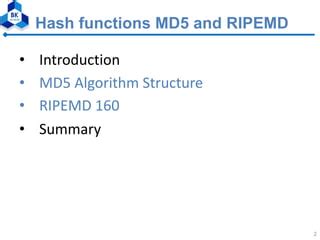Hash Algorithm Evolution: Why RIPEMD-160 Was Chosen Before SHA-1
At the dawn of the development of blockchain technology, two popular hashing algorithms became widespread: SHA-1 and RIPEMD-160. Although both algorithms have their strengths and weaknesses, they differ in several key aspects that led to the choice of one of them.
SHA-1: Old Algorithm
SHA-1 (Secure Hash Algorithm 1) was introduced in 2000 by Ronald Rivest and his colleagues. It is designed for fast and efficient data integrity checking, which makes it a popular choice in many applications. However, the limitations of SHA-1 soon became apparent. Its hash values are relatively large, which can make it prone to collisions (different inputs give the same result). This made it unsuitable for cryptographic purposes.
RIPEMD-160 RETURN
In 1995, J.K. Kelsey and Ronald Rivest developed RIPEMD-160, a cryptographically secure hash function designed specifically for checking the integrity of messages. It was introduced to eliminate the limitations of SHA-1 by providing better security and collision resistance. One of the main advantages of RIPEMD-160 is a smaller footprint compared to SHA-1.
Decision between SHA-1 and RIPEMD-160

In 2014, the Internet Engineers Group (IETF) voted to deprecate SHA-1 in favor of more secure alternatives such as SHA-256. The decision was made taking into account several factors:
- Resistance to collisions: SHA-1’s vulnerability to collisions has made it less suitable for cryptographic applications.
- Key size limitations: SHA-1 requires a 160-bit key, which is insufficient for some use cases.
Why was RIPEMD-160 chosen
Although the transition from SHA-1 to SHA-256 was inevitable, the decision to adopt RIPEMD-160 as a secondary option reflects its unique strengths. Here are some reasons:
- Shorter hash values: RIPEMD-160 creates shorter hash values compared to SHA-1, which makes it more efficient in certain use cases.
- Enhanced Security: RIPEMD-160’s encryption capabilities provide more reliable protection against attacks and vulnerabilities.
- Compatibility with existing systems: Many organizations have already invested in the implementation of RIPEMD-160, which ensures a smooth transition.
Effect of choice
Although SHA-1 is no longer widely used, its legacy continues to influence the development of secure hash functions. The choice between SHA-256 and other alternatives such as SHA-3 (eg, Keccak) was driven by the need for more efficient and secure algorithms in cryptographic applications.
In summary, choosing RIPEMD-160 over SHA-1 reflects its strengths as a message integrity algorithm, including smaller output sizes, increased security, and compatibility with existing systems. This decision emphasizes the importance of evaluating the various decentralization functions in light of their specific use cases and security requirements.

Leave Your Comment